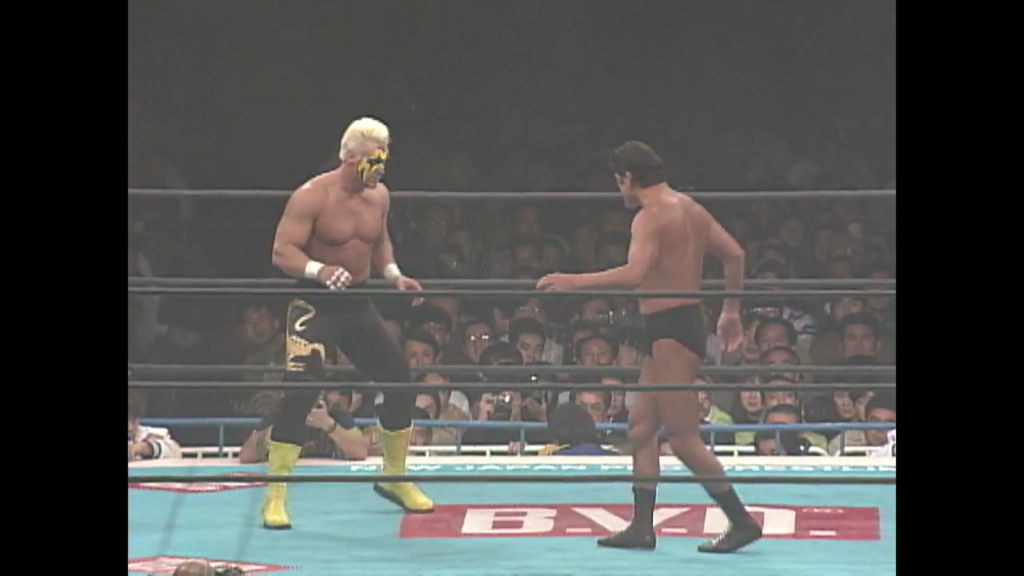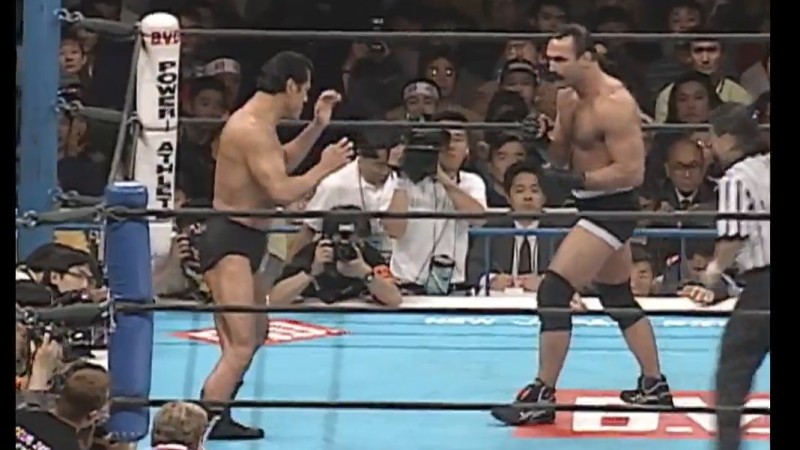Antonio Inoki passed away in October 2022, ending the life of one of the greatest wrestlers of all time.
In the ring, he transformed pro-wrestling in Japan, with his cross-promotional matches with the likes of Muhammad Ali and Don Frye transforming Mixed-Martial Arts.
However, as a promoter, he also created the modern-day wrestling that Japan enjoys. Forming New Japan Pro Wrestling in 1972, he quickly grew the company to the biggest in the country, until he was ousted from the company in 2005.
There are so many interesting stories about the life of Antonio Inoki, it is hard to narrow it down to just ten. We’ve done our best, so enjoy our list of the 10 best facts about Antonio Inoki you won’t believe are true.
10. Antonio Inoki Won The WWE Championship, But Vince McMahon Refused To Recognize It

In 1979, Antonio Inoki defeated Bob Backlund to win the WWE Championship. You may not have heard of this title change, because the WWE refuse to ever acknowledge that it happened.
Even in Inoki’s WWE Hall of Fame induction, the company neglected to admit that this ever happened.
In a match against Bob Backlund in Tokushima, Japan, Antonio Inoki won the WWF Championship. In a nearly 30 minute encounter, Inoki won the match due to outside help to disctract Backlund.
Tiger Jeet Singh, the Indo-Canadian wrestling legend, ran to ringside, distracting WWF Champion Bob Backlund and allowing Inoki to pin him for the victory.
It was a rather cheap way to win the title, and the then WWF President Hishashi Shinma declared the win illegitmate, forcing Inoki to vacate the belt soon after.
However, the company never acknowledges this, and don’t even admit that there is video footage of both the title win, and Backlund winning the belt back a week later.
Read more about Antonio Inoki’s WWE Championship win.
9. He Once Stopped A Luke Gallows Bout Mid-Match, Before Attacking The Commentator

Nobody has ever claimed that Luke Gallows is a top-class wrestler, but even he will feel hard done by after having Antonio Inoki interrupt one of his matches, simply for the crime of being terrible.
In a match in the Inoki Genome Federation, Luke Gallows put on an absolute stinker against Sylvester Terkay. The match was so bad that Antonio Inoki ran in mid-match, forcing the match to be stopped and sending the two wrestlers to the back.
Inoki even slapped Masahiro Chono, who had no part of the bout but was working on commentary that night. This was just one of the many issues that plagued the IGF, and eventually led to the company’s downfall.
Read more about Antonio Inoki and Luke Gallows.
8. “Inoki-Ism” Nearly Put New Japan Pro Wrestling Out Of Business

In the late 1990s and early 2000s, Inoki-ism nearly killed New Japan Pro Wrestling.
The concept of Inoki-ism sought to turn wrestling into more of a sport, focusing on more MMA-style wrestling, and moving away from what the fans wanted in a professional wrestling match.
In addition, Inoki (who booked NJPW at the time) only pushed wrestlers who could actually fight. He put his wrestlers into real MMA fights, pushing the winners as top stars while casting aside those who were not training in “real” fighting.
Fans quickly tuned out, and ticket sales plummeted. Yukes (the video game company) bought NJPW and ousted Antonio Inoki as company president, allowing him to start another promotion based on Inokism – the Inoki Genome Federation.
Learn more about Inoki-ism.
7. Antonio Inoki Wrestled Sting In NJPW, and The Match Was Terrible

In a NJPW tournament in 1985, Sting made the trip over to NJPW to wrestle against Antonio Inoki. While Inoki went to WCW in 1994, he only wrestled against William Regal, not crossing paths with “The Icon” during his trip.
However, their dream match in Japan turned out to actually be terrible. In the final match of the BVD Martial Arts Tournament, Inoki-ism was in full force.
The bout was a slow, boring grappling exhibition, with most of the match consisting of just wrestling holds, with the occasional punch and body slam.
Sting’s dynamism and charisma was not utilized in this match at all, and he wasn’t given anything to do by the 52-year-old Inoki. Of course, the NJPW President picked up the win to the delight of the fans, who chanted “Inoki!” throughout the bout.
Read more about Antonio Inoki vs Sting.
6. His Last Match Was A Confusing Exhibition On A Kickboxing Show

Antonio Inoki wrestled his last proper match on New Year’s Eve 2001, at one of his “Inoki Bom-Ba-Ye” events.
These stadium shows combined the worlds of kickboxing, MMA and occasionally professional wrestling, to create a festival of fighting that fans of professional wrestling and martial arts could enjoy.
Inoki was 60-years-old in his last match, which came five-years after his official retirement match in New Japan Pro Wrestling.
However, he came out of retirement for a grappling exhibition match with Renzo Gracia in 2003, showcasing the art of mixed-martial arts that had become a force in Japan, with promotions like PRIDE and K1 overtaking wrestling in popularity.
Wanting to combine the best of both worlds, Inoki created “Inoki-ism” and began to bleed MMA into pro-wrestling (with disastrous results). This match showcased this, as Inoki and Gracie grappled each other around the ring for one three-minute round, showcasing what Inoki-ism could become in professional wrestling.
However, the legend could not end his career there. One more bout against Tatsumi Fujinami awaited him at Fujinami’s retirement show, but it was one step too far.
While the 62-year-old legend was long retired, he put on a good, technial performance against his long-time friend, but was choked out by Fujinami to end this impromptu match and end his career for good.
While this is not technically his last match, as the bell never rang and there was no referee, It would be remiss to not include it when talking about Antonio Inoki’s last match.
5. Inoki Attacked His Opponent Mid-Match For Going Off Script

One of the funniest times a match as gone wrong is when Antonio Inoki battled the similarly named The Great Antonio.
The match is famous for The Great Antonio’s refusal to work with Inoki, no-selling his offense and trying to hurt the Japanese legend in the process.
Not one to be deterred nor insulted, Antonio Inoki completely turned. He began to slap the taste out of Antonio’s mouth, slapping him repeatedly until he fell to the groud.
Inoki then began to boot him in the head with all his might, until the referee was forced to end the match as Inoki seethed in the corner.
You can see a clip of the match down below, narrated by American Comedian Bill Burr.
4. He Lost To Hulk Hogan In A Match To Become The First IWGP Heavyweight Champion

While we usually think of Hulk Hogan as one of the greatest WWE Champions of all time, or even as his role in WCW as the head of the NWO, he has a long and storied career over in Japan as well.
Antonio Inoki is considered an all-time great in Japan, and almost synonymous with the IWGP Heavyweight Championship. Considering he founded NJPW in 1972, it makes sense that Inoki would be the first IWGP Heavyweight Champion.
Not the case.
In fact, in 1983, Hulk Hogan won the G1 Climax to become the first ever world champion in New Japan Pro Wrestling.
Hogan beat legends like Antonio Inoki, Andre the Giant and Big John Studd to win the tournament and be awarded the IWGP Heavyweight Championship, before dropping it to Antonio Inoki one year later.
Learn more about Hulk Hogan’s IWGP Heavyweight Championship win.
3. He Was Not Born As Antonio Inoki

While he is widely known as Antonio Inoki, the Japanese legend was not born under that name, nor was he known as it when he died.
He was born Kanji Inoki on 20 February 1943 in Yokohama, Kanagawa, Japan. Born during World War II, he grew up in the aftermath of the US Atomic bombing of Hiroshima and Nagasaki, so used the countries hated of the US in helping build his wrestling promotion.
However, he changed his name to Muhammad Hussain Inoki in 1990, after a pilgramage to Japan.
Here, he converted to Islam (Although still retained his appreciation for Buddism), and remained known as Muhammad Hussain Inoki until he died. However, he was professional known as Antonio Inoki in wrestling, which was an homage to fellow professional wrestler Antonino Rocca
2. Antonio Inoki Wrestled Ric Flair in North Korea

In 1995, WCW partnered with Antonio Inoki to put on an iconic and infamous show in North Korea. Following the death of Kim-Il Sung, new leader Kim-Jong Il sought to put on a huge sporting event to reinvigorate the Korean people.
The answer was professional wrestling. Tasked with putting on the biggest show ever, Ali courted the likes of Ric Flair and the Steiners to wrestle in front of 300,000 fans in two nights, ending in a show attendended by 190,000 fans to watch Antonio Inoki vs Ric Flair.
The match was strange, as it was the only one where the fans actually cheered. They knew that Inoki was trained by Rikidozan (the North Korean wrestler and father of wrestling in Japan), so considered him the babyface in the match. Ric Flair did not enjoy himself however, and couldn’t wait to get home after being held hostage for three days.
Read more about why Ric Flair hated wrestling in North Korea.
1. Inoki Invented MMA By Fighting Muhammad Ali

It has been claimed that Antonio Inoki invented the concept of Mixed Martial Arts, during one of his cross-promotional fights in the 1970s. His 1976 bout with Muhammad Ali is one of the most watched wrestling matches ever, with an alleged 1.4 billion people from across the globe tuning in for the iconic boxer vs wrestler match.
However, the bout looked more like a modern-day MMA fight than a wrestling match. The rules of the match couldn’t be decided at first, with a cross between boxing and wrestling chosen just minutes before the bout. Due to this, Inoki lay on his back and flung huge kicks into the calves of Ali, knowing he could not punch him when he was that low.
This was not just one of the most watched wrestling matches of all time, but actually was said to have inspired the creation of MMA, with promotions like the UFC having to thank Antonio Inoki and his “Inoki-ism” for their creation.